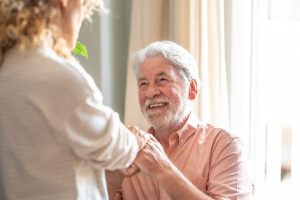
Coming home after a stroke is much easier when you know what to expect and how to handle any challenges that arise.
Finally, the hospital stay is over. The whirlwind of doctors, machines, and clinical buzz has quieted. And now you’re staring at the front door, keys in hand, thinking: What now?
If someone in your life is coming home after a stroke, you already know there will be challenges ahead. But unlike a movie, stroke recovery doesn’t come with a script. The questions pile up fast, and most families have no idea where to start.
Let’s walk through some of the biggest questions people have once the dust settles and the reality of stroke recovery at home sets in.
How long does stroke recovery take?
It’s the million-dollar question, with the least satisfying answer: it depends. Recovery can unfold over weeks, months, or even years. Some people regain function quickly, while others make slower but steady progress. Don’t judge recovery by the calendar. Celebrate the small wins, like holding a fork again or saying a full sentence. Those are big deals.
Is full recovery even possible?
It certainly can be, but not always in the way you expect. “Full recovery” might mean walking without a cane, or it might mean finding a new way to do things with the abilities someone does have. Neuroplasticity (the brain’s ability to rewire and create new pathways) is powerful, but it works best with repetition, support, and time. The person might not return to life exactly as it was, but that doesn’t mean life can’t still be meaningful, active, and joyful.
What should we actually do all day?
Stroke recovery involves everyday moments just as much as scheduled therapy appointments. Folding towels can double as hand therapy. Reading out loud can support speech recovery. Playing cards is great for memory, focus, and fine motor skills. Every interaction is an opportunity for progress. The trick is to mix activity with rest and avoid overwhelming your loved one (or yourself).
Should I be worried about depression or mood changes?
Yes, and not because anything has gone wrong. It’s incredibly common for people recovering from a stroke to experience depression, anxiety, or emotional outbursts. Stroke affects the brain, and that includes the parts that manage emotion. If you notice signs like persistent sadness, disinterest, or irritability, talk to a medical professional. Mental health support is just as vital as physical rehab.
What if their personality seems different?
This can be one of the hardest parts of stroke recovery: feeling like you’re caring for someone who’s no longer quite the same. Maybe they laugh at odd times or seem more withdrawn. These changes are real and can stem from both brain injury and the emotional weight of what they’ve experienced. It’s okay to grieve the shift, and it’s also okay to hope for new patterns to emerge as healing continues.
How do I handle my own burnout?
Caregiver fatigue is not a badge of honor – it’s a signal. You can’t pour from an empty cup, and stroke recovery is often a marathon, not a sprint. Schedule breaks. Say yes when someone offers help. Explore in-home care options so you can rest without guilt. You’re not abandoning your loved one; you’re preserving your ability to keep showing up.
What if we hit a plateau?
Progress doesn’t always follow a straight line. There might be fast improvements in the first few weeks, followed by what feels like a long stall. That’s normal. Keep showing up, keep encouraging movement and engagement, and don’t hesitate to talk to the rehab team about new strategies. Sometimes a small tweak, like switching therapists or adding a new activity, can restart momentum.
What kinds of therapies should we expect?
It depends on the stroke’s effects. Common therapies include:
- Physical therapy: for balance, walking, and strength
- Occupational therapy: for daily tasks like dressing, eating, and bathing
- Speech therapy: for communication, swallowing, and memory
- Cognitive therapy: for problem-solving, focus, and safety awareness
Each of these can often be brought into the home, making recovery more comfortable and less intimidating.
How will we know if something is wrong again?
The risk of another stroke is real, especially in the first year. Learn the warning signs using the FAST acronym: Face drooping, Arm weakness, Speech difficulties, Time to call 911. Talk to the doctor about prevention strategies, medication schedules, and health monitoring to reduce risks.
There’s no one “right” way to recover from a stroke. Every journey looks different, and every day brings new questions. The key is to stay curious, stay connected, and give yourself grace.
Looking for extra support in a loved one’s stroke recovery journey?
At Advanced Home Health Care, we provide specialized in-home care that extends comfort, promotes healing, and brings peace of mind. Reach out to us at 800.791.7785 to explore how home-based stroke recovery support can make all the difference for someone you love in Burlington, Mount Pleasant, Mediapolis, or anywhere else in Southeast Iowa.

